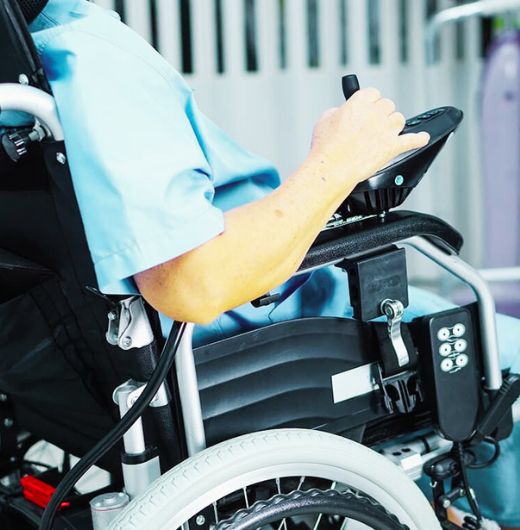Hamilton Catastrophic Injury Lawyers – Serving Accident Victims throughout Ontario since 2003. No Fees Unless we Win.
Free Consultations Provincewide. Call 905-333-8888 or Send us a Message Today.
Don’t settle for less than you deserve. Contact us today for a free, no-obligation consultation. We work on a contingency basis, which means you don’t pay unless we win your case.
When you or a loved one has been involved in a serious accident, it can be a challenging and overwhelming experience. One of the terms you may come across when dealing with the legal and insurance aspects of your case is “catastrophic impairment.” While the term may sound daunting, it is essential to understand what it means and how it can impact your access to accident benefits.
Achieving a catastrophic impairment designation significantly increases the benefits available to an accident victim. Under the SABS, individuals with this classification are entitled to up to $1 million in combined medical, rehabilitation, and attendant care benefits over their lifetime. This is a substantial increase compared to the $65,000 limit for non-catastrophic injuries. These enhanced benefits are designed to support extensive medical treatments, rehabilitation services, and personal care required for recovery and daily living.
What is a Catastrophic Impairment?
A catastrophic impairment is a severe, life-altering injury that results from an accident occurring on or after June 1, 2016, as defined by the Statutory Accident Benefits Schedule (SABS) in Ontario. These impairments can include:
- Paraplegia or tetraplegia (paralysis of the lower or upper body)
- Severe impairment of mobility, arm use, or amputation
- Loss of vision in both eyes
- Traumatic brain injury (for those 18 years or older at the time of the accident)
- Traumatic brain injury (for those under 18 years at the time of the accident)
- Physical impairment(s) resulting in 55% or more impairment of the whole person
- Mental or behavioural impairment, combined with a physical impairment, resulting in 55% or more impairment of the whole person
- Impairment resulting in marked or extreme impairment in multiple areas of function due to a mental or behavioural disorder
Each of these categories has specific criteria that must be met to be considered a catastrophic impairment. These criteria may include the severity of the impairment, the results of medical assessments, and the time elapsed since the accident.
It is important to note that for children and teenagers under 18 at the time of the accident, the criteria for catastrophic impairment may be adapted to account for their ongoing development.
If you or a loved one has suffered a severe injury in an accident, it is crucial to work with experienced legal and medical professionals who can help you navigate the complex process of determining whether your impairment qualifies as catastrophic under the SABS. This determination can significantly impact the level of accident benefits and support you receive during your recovery and in the long term.
Over $65 million for Hamilton Catastrophic Injury Victims across since 2003.
Our SuccessParaplegia or Tetraplegia (paralysis of the lower or upper body)
When an accident results in paraplegia or tetraplegia, it can be a life-changing event that profoundly impacts the injured person and their loved ones. The Statutory Accident Benefits Schedule (SABS) in Ontario recognizes the severity of these conditions and provides specific criteria to determine when they are considered catastrophic impairments, which can affect the level of benefits and support available to the injured person.
Paraplegia is a type of paralysis that affects the lower body, typically due to a spinal cord injury in the thoracic, lumbar, or sacral regions of the spine. Tetraplegia, also known as quadriplegia, is paralysis affecting both the upper and lower body, usually resulting from a spinal cord injury in the cervical (neck) region.
According to the SABS, for paraplegia or tetraplegia to be considered a catastrophic impairment, the following criteria must be met:
- The injured person’s neurological recovery has reached a point where their permanent grade on the ASIA (American Spinal Injury Association) Impairment Scale can be determined. This scale is used to assess the severity of the spinal cord injury by evaluating the preservation of sensory and motor function below the level of the injury.
- The permanent ASIA Impairment Scale grade must be:
- A, B, or C, or
- D, with additional criteria related to mobility, urological, or anorectal function
The ASIA Impairment Scale grades spinal cord injuries from A to E, with A being the most severe and E representing normal sensory and motor function. Grades B, C, and D indicate varying levels of incomplete spinal cord injury, with some preservation of sensory and/or motor function below the level of the injury.
If the injured person’s ASIA Impairment Scale grade is D, they must also meet one of the following criteria to be considered a catastrophic impairment:
- A low score on the Spinal Cord Independence Measure, indicating severe limitations in indoor mobility
- The need for urological surgical diversion, an implanted device, or catheterization to manage neuro-urological impairment
- Impaired voluntary control over anorectal function, requiring a bowel routine, surgical diversion, or an implanted device
Coping with paraplegia or tetraplegia can be an emotional and challenging journey for both the injured person and their family. It is crucial to seek support from medical professionals, rehabilitation specialists, and mental health experts who can provide guidance and assistance throughout the recovery process. Additionally, working with experienced legal professionals can help ensure that you receive the accident benefits and resources you need to adapt to your new circumstances and maintain the best possible quality of life.
Remember, you are not alone in this journey. There are resources and support systems available to help you navigate the challenges and advocate for your rights under the SABS. Don’t hesitate to reach out for help when you need it.


Severe Impairment of Mobility, Arm use, or Amputation
When an accident results in severe impairment of mobility, arm use, or amputation, it can be a devastating experience for the injured person and their loved ones. The Statutory Accident Benefits Schedule (SABS) in Ontario recognizes the significant impact these impairments can have on an individual’s life and outlines specific criteria for determining when they are considered catastrophic impairments.
According to the SABS, severe impairment of mobility, arm use, or amputation is considered a catastrophic impairment if the injured person meets one of the following criteria:
- Severe impairment of ambulatory mobility:
- The injured person is unable to walk independently, with or without the use of assistive devices, for a continuous distance of 100 meters or more on level ground, or
- They can only walk independently with an assistive device at a speed of less than 0.67 meters per second on level ground
- Severe impairment of upper limb use:
- The injured person has a complete loss of use of both arms, or
- They have a complete loss of use of one arm, accompanied by a severe and permanent alteration of prior structure and function involving one or both arms, as determined by a combination of medical findings, including sensory or motor impairment, decreased range of motion, atrophy changes on diagnostic imaging, or other medically recognized criteria
- Amputation:
- The injured person has had one or both arms amputated above the wrist, or
- They have had one or both legs amputated above the ankle, resulting in the complete and permanent loss of use of the amputated limb
These criteria help medical professionals and legal representatives determine the severity of the impairment and whether it qualifies as a catastrophic impairment under the SABS. It is important to note that meeting these criteria does not automatically guarantee access to enhanced accident benefits, as there may be additional requirements or assessments necessary.
Dealing with severe impairment of mobility, arm use, or amputation can be a challenging and emotional journey. It is essential to work closely with your medical team, rehabilitation specialists, and mental health professionals to develop a comprehensive treatment and support plan. Occupational therapists and other experts can help you adapt to your new circumstances and explore assistive devices, modifications, and strategies to maintain your independence and quality of life.
In addition to medical support, it is crucial to work with experienced legal professionals who can guide you through the process of accessing the accident benefits and resources you need. They can help you understand your rights under the SABS and advocate on your behalf to ensure that you receive the support you deserve.
Remember, you are not alone in this journey. There are resources and support systems available to help you navigate the challenges and rebuild your life after a severe impairment or amputation. Don’t hesitate to reach out for help and support when you need it, and know that there are people who understand what you are going through and are ready to assist you every step of the way.
Catastrophic Brain Injury (Over 18 years old)
When someone 18 years or older experiences a brain injury in an accident, it can be life-altering for both the individual and their loved ones. The Statutory Accident Benefits Schedule (SABS) in Ontario acknowledges the seriousness of these injuries and outlines specific criteria to determine when a brain injury is considered a catastrophic impairment.
According to the SABS, a brain injury in an adult is considered a catastrophic impairment if:
- Six months or more after the accident, the injured person scores a 2 (vegetative state) or 3 (severe disability) on the Glasgow Outcome Scale (GOS), which assesses the outcomes of brain injury patients.
- The injured person has marked or extreme impairment in a specified number of areas due to a brain impairment, as outlined in the American Medical Association’s Guides to the Evaluation of Permanent Impairment:
- For those aged 18 to 64, impairment must be present in at least three areas.
- For those aged 65 or older, impairment must be present in at least two areas.
The areas considered include daily living activities, social functioning, concentration/persistence/pace, and adaptation.
Dealing with a brain injury can be challenging, as it may result in physical, cognitive, and emotional changes that require ongoing support and rehabilitation. It’s essential for individuals with brain injuries and their families to work with a team of medical professionals to develop a personalized treatment and rehabilitation plan.
Legal professionals experienced in accident benefits can also help guide you through the process of accessing the resources and support you need. They can assist you in understanding your rights under the SABS and advocate on your behalf.
Remember, recovery from a brain injury is a unique journey, and progress may be gradual. Be patient, celebrate small victories, and don’t hesitate to reach out for help when needed. There are resources and support systems available to help you navigate this challenging time.

Experience Matters
A few of our recent result are noted below. Past results are not necessarily indicative of future results and litigation outcomes will vary according to the facts of individual cases. The information below are examples of Matt Lalande’s cases that he has settled or tried to verdict over his career and is for informational purposes only.
View More Case ResultsFor a young man who lost 2 limbs in a motorcycle accident.
For a Catstrophically Injured Motorcyclist who Crashed in NY.
For a middle aged woman who suffered a catastrpophic brain injury.
Catastrophic Brain Injury (Under 18 Years Old)
When a child under the age of 18 suffers a brain injury in an accident, it can have a significant impact on their development and future. The Statutory Accident Benefits Schedule (SABS) in Ontario recognizes the unique challenges faced by children with brain injuries and provides specific criteria for determining when a brain injury is considered a catastrophic impairment in this age group.
According to the SABS, a brain injury in a child under 18 years old is considered a catastrophic impairment if the child meets one of the following criteria:
- The child is accepted for admission, on an in-patient basis, to a public hospital named in a Guideline issued by the Ontario Neurotrauma Foundation for pediatric neurorehabilitation.
- The child’s level of neurological function does not exceed category 2 (vegetative) or 3 (severe disability) on the King’s Outcome Scale for Childhood Head Injury (KOSCHI).
- Category 2 (vegetative) indicates a continuing vegetative state with no meaningful responsiveness.
- Category 3 (severe disability) indicates severe disability, where the child is at least intermittently able to move part of the body/eyes to command or make purposeful spontaneous movements.
- The child has, according to a test administered by a physician or neuropsychologist, an impairment of brain function that results in a score of 9 or less on either the Glasgow Coma Scale (GCS) or the Pediatric Glasgow Coma Scale (PGCS).
Dealing with a brain injury in a child can be emotionally challenging for the entire family. It’s crucial to work closely with a team of pediatric specialists, including neurologists, physiatrists, neuropsychologists, and rehabilitation therapists, to develop a comprehensive treatment and rehabilitation plan that addresses the child’s specific needs.
In addition to medical support, it’s essential to work with experienced legal professionals who can guide you through the process of accessing the accident benefits and resources your child needs. They can help you understand your rights under the SABS and advocate on your behalf to ensure that your child receives the support they deserve.
Remember, every child’s journey with a brain injury is unique, and progress may be gradual. It’s important to be patient, celebrate small milestones, and provide a supportive and nurturing environment for your child. Don’t hesitate to reach out for help and support when needed, as there are resources and systems available to assist you and your child during this challenging time.
Physical Impairment(s) Resulting in 55% or more Impairment of the Whole Person
In Ontario, the Statutory Accident Benefits Schedule (SABS) provides essential support to individuals injured in motor vehicle accidents. A key aspect of this support is the classification of injuries as “catastrophic impairments, which grants access to enhanced benefits. One criterion for this designation is sustaining physical impairments that result in a 55% or greater Whole Person Impairment (WPI).
WPI is a comprehensive assessment that quantifies how your injuries affect your overall functioning. A licensed physician evaluates the severity of each injury you’ve sustained, assigning specific impairment percentages based on established guidelines. These individual ratings are then combined to determine your total WPI. If the cumulative impairment equals or exceeds 55%, your condition is classified as catastrophic.
This catastrophic designation significantly increases the benefits available under the SABS. For example, the maximum coverage for medical and rehabilitation benefits rises from $65,000 for non-catastrophic injuries to $1 million for catastrophic injuries. Additionally, you may become eligible for attendant care benefits, housekeeping and home maintenance benefits, and caregiver benefits, which are not accessible for non-catastrophic injuries.
Assessments for catastrophic impairment are typically conducted after two years have passed since the accident. However, if your condition is unlikely to improve to less than 55% impairment, an assessment can be performed as early as three months post-accident. This ensures that individuals with severe injuries can access the enhanced benefits they need without unnecessary delays.
If you believe your injuries may qualify as a catastrophic impairment, it’s crucial to consult with your healthcare provider and a legal professional experienced in personal injury law. They can guide you through the assessment process and help ensure you receive the benefits necessary for your recovery.
Navigating the aftermath of a severe accident is undoubtedly challenging. Understanding the provisions within the SABS can be instrumental in accessing the support you need during this difficult time.

I can’t thank them enough for the support they provided us during the crisis we went through. Special thanks to Heather who was my first point of contact for every issue I faced and she was so prompt and professional in every way. I am glad we chose Lalande to serve us – Sukhmani Grewal, HWY 69 Head-On Collision.
Mental or Behavioural Impairment, Combined with a Physical Impairment, Resulting in 55% or More Impairment of the Whole Person
Understanding Mental or Behavioral Impairments
Mental or behavioral impairments refer to psychological conditions that affect an individual’s emotional and cognitive functioning. These can include disorders such as depression, anxiety, post-traumatic stress disorder (PTSD), and other mental health conditions that may arise following a traumatic event like a motor vehicle accident. The severity of these impairments is assessed by mental health professionals who evaluate how these conditions impact daily activities, social interactions, concentration, and the ability to adapt to work or work-like settings.
Understanding Physical Impairments
Physical impairments encompass injuries that affect the body’s structure or function. Examples include spinal cord injuries leading to paralysis, loss of limb function, severe fractures, or chronic pain conditions. Medical professionals assess these impairments by examining the extent of physical limitations, the impact on mobility, and the ability to perform daily tasks.
Combining Mental and Physical Impairments to Determine Whole Person Impairment (WPI)
The concept of Whole Person Impairment (WPI) is used to quantify the overall impact of an individual’s combined impairments on their entire person. To determine if the combined impairments meet or exceed the 55% threshold for catastrophic impairment, the following process is typically followed:
- Assessment of Individual Impairments: Medical and mental health professionals conduct comprehensive evaluations to assign impairment ratings to each condition. These ratings are based on standardized guidelines, such as the American Medical Association’s Guides to the Evaluation of Permanent Impairment.
- Combining Impairment Ratings: The individual impairment percentages are not simply added together. Instead, a specific formula is used to combine them, reflecting the cumulative effect on the whole person. This method ensures that the combined impact accurately represents the overall level of impairment.
- Determination of WPI Percentage: The result of this combination yields a WPI percentage. If this percentage is 55% or higher, the individual is classified as having a catastrophic impairment under Ontario law.
Understanding the process of combining mental or behavioral impairments with physical impairments to determine a 55% or greater Whole Person Impairment is crucial for accident victims seeking appropriate compensation and support. This classification acknowledges the profound impact of combined injuries on an individual’s life and ensures access to the necessary resources for recovery and daily functioning.
Impairment Resulting in Marked or Extreme Impairment in Multiple Areas of Function due to a Mental or Behavioural Disorder
Based on the Statutory Accident Benefits Schedule (SABS) in Ontario Regulation 34/10 under the Insurance Act, catastrophic impairment due to a mental or behavioural disorder is defined in section 3.1(1)8 as:
An impairment that, in accordance with the American Medical Association’s Guides to the Evaluation of Permanent Impairment, 4th edition, 1993, results in a class 4 impairment (marked impairment) in three or more areas of function that precludes useful functioning or a class 5 impairment (extreme impairment) in one or more areas of function that precludes useful functioning, due to mental or behavioural disorder.
To be deemed catastrophically impaired under this criterion, an individual must have a mental or behavioural disorder that results in either:
- Class 4 impairment (marked impairment) in at least 3 areas of functioning, or
- Class 5 impairment (extreme impairment) in 1 or more areas of functioning
The impairment must preclude useful functioning in those areas. The assessment is done in accordance with the AMA Guides to the Evaluation of Permanent Impairment, 4th edition.
The AMA Guides specify 4 areas of functioning:
- Activities of daily living
- Social functioning
- Concentration, persistence and pace
- Adaptation to stressful circumstances
Each area of functioning is rated on a 5-point scale:
- Class 1: No impairment
- Class 2: Mild impairment
- Class 3: Moderate impairment
- Class 4: Marked impairment
- Class 5: Extreme impairment
Impairment levels are defined as follows:
Class 4 – Marked Impairment: Impairment levels significantly impede useful functioning.
Class 5 – Extreme Impairment: Impairment levels preclude useful functioning.
In summary, to be deemed catastrophically impaired due to mental or behavioural disorder under the Ontario SABS, an individual must have marked impairment in at least 3 of the 4 areas of functioning, or extreme impairment in 1 or more areas. The impairment must significantly impede or preclude useful functioning as a result of a mental or behavioural disorder. Assessment is based on the AMA Guides 4th edition rating criteria for mental and behavioural impairments.


We Specialize in Complex Catastrophic Injury Cases
Navigating the aftermath of a serious accident can be an overwhelming and challenging experience for both the injured person and their loved ones. One of the most important aspects of this process is understanding the concept of catastrophic impairment and how it can impact your access to accident benefits under Ontario’s Statutory Accident Benefits Schedule (SABS).
It is important to remember that every individual’s journey after a serious accident is unique, and there is no one-size-fits-all approach to recovery. Whether you are dealing with the challenges of paraplegia, tetraplegia, severe impairment of mobility or arm use, amputation, loss of vision, traumatic brain injury, or a combination of physical and mental impairments, it is crucial to have a strong support system in place. This includes medical professionals, rehabilitation specialists, mental health experts, and legal advocates who can guide you through the process and help you access the resources and benefits you need.
Remember, you are not alone in this journey. At Lalande Personal Injury Lawyers, we take pride in being trusted Hamilton Catastrophic Injury Lawyers since 2003. Over the years, we’ve helped our clients recover more than $45 Million in settlements and verdicts in serious cases. Whether you’re dealing with a life-changing injury, a denied disability claim, wrongful death, a hurt child or employment termination, we are here to provide compassionate and experienced legal representation. If you believe you have a case, call us today—we’re ready to help you secure the compensation you deserve.
Call Lalande Personal Injury Lawyers today, no matter where you are in Ontario at 905-333-8888 for your free consultation. Alternatively, you can contact us online, confidentially, by filling out a contact form.
Hamilton Catastrophic Injury Lawyer FAQ
In Ontario, a catastrophic injury is a severe, life-altering injury that significantly impacts an individual’s daily life and employment. The Statutory Accident Benefits Schedule (SABS) outlines the conditions that qualify as catastrophic impairment, such as paraplegia, tetraplegia, severe physical impairments, and traumatic brain injury.
A Hamilton catastrophic injury lawyer can help you navigate the complex legal process, gather evidence to support your claim, negotiate with insurance companies, and fight for the compensation you deserve. They can also connect you with medical and rehabilitation resources to aid in your recovery.
Compensation for a catastrophic injury in Hamilton may include damages for medical expenses, lost wages, pain and suffering, loss of enjoyment of life, and future care costs. The amount of compensation depends on the severity of the injury and its impact on your life.
Yes, an amputation can be considered a catastrophic injury under the SABS if it involves the total and permanent loss of use of an arm or a leg, or the complete severance of an arm or a leg above the wrist or ankle.
A traumatic brain injury can be considered a catastrophic impairment if it results in a score of 9 or less on the Glasgow Coma Scale (GCS), as published in Jennett, B. and Teasdale, G., Management of Head Injuries, Contemporary Neurology Series, Volume 20, F.A. Davis Company, Philadelphia, 1981.
Yes, a spinal cord injury resulting in paraplegia or tetraplegia (complete paralysis of the lower limbs or all four limbs) is considered a catastrophic impairment under the SABS.
A mental or behavioral disorder can be considered a catastrophic impairment if it results in a Class 4 impairment (marked impairment) in three or more areas of function, or a Class 5 impairment (extreme impairment) in one or more areas of function, according to the American Medical Association’s Guides to the Evaluation of Permanent Impairment, 4th edition, 1993.
Many Hamilton catastrophic injury lawyers work on a contingency fee basis, meaning they only get paid if they win your case. The fee is typically a percentage of the settlement or court award. Initial consultations are often free, allowing you to discuss your case without upfront costs.
Catastrophic injuries in Hamilton can result from various accidents, including car collisions, pedestrian accidents, bicycle accidents, motorcycle accidents and slip and falls. Any accident that causes severe, life-changing injuries may be considered catastrophic.
When choosing a Hamilton catastrophic injury lawyer, consider factors such as their experience with catastrophic injury cases, their track record of success, their communication skills, and their availability to answer your questions. Look for a lawyer who offers a free initial consultation and works on a contingency fee basis to minimize your financial risk.


